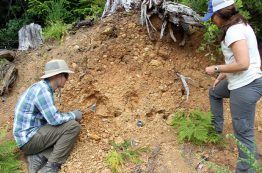Last year for International Mountain Day, we visited the shores of Mauna Kea in Hawaii and learned that it’s the tallest mountain in the world when measured from the base underwater up to the top. This year, we are travelling to colder climates to the highest mountain in the world when measured from sea level: Mount Everest. Department of Earth and Space Sciences’ Howard Conway officially had one of the most scenic offices in the world when he conducted field work on the Khumbu Glacier, one of the four major glaciers that flank Mount Everest.
Read more »Most landslides in western Oregon triggered by heavy rainfall, not big earthquakes
Researchers at the University of Washington, Portland State University and the University of Oregon have shown that deep-seated landslides in the central Oregon Coast Range are triggered mostly by rainfall, not by large offshore earthquakes. The open-access paper was published Sept. 16 in Science Advances. “Geomorphologists have long understood the importance of rainfall in triggering landslides, and our study is simply driving home just how important it is,” said first author Sean LaHusen, who did the work as part of his doctorate at the UW.
Read more at UW News »February lockdown in China caused a drop in some types of air pollution, but not others
Atmospheric scientists have analyzed how the February near-total shutdown of mobility affected the air over China. Results show a striking drop in nitrogen oxides, a gas that comes mainly from tailpipes and is one component of smog. Learning how behavior shifts due to the COVID-19 pandemic affect air quality is of immediate importance, since the virus attacks human lungs. The event is also a way for Earth scientists to study how the atmosphere responds to sudden changes in emissions.
Read more at UW News »David Montgomery elected to the Washington State Academy of Sciences in 2020
David Montgomery, professor of Earth and Space Sciences at the University of Washington, has been elected to the Washington State Academy of Sciences, according to an announcement July 15 by the academy. The new members are lauded for “their outstanding record of scientific and technical achievement and their willingness to work on behalf of the academy to bring the best available science to bear on issues within the state of Washington.”
Read more at UW News »Katharine Huntington helps define the next decade in Earth sciences
It is easy to feel lost when thinking of the vast scope of Earth sciences. After all, Earth sciences covers everything from the microscopic interactions of bacteria all the way to natural hazards like earthquakes and tsunamis. So how do scientists narrow down such a vast subject to prioritize investments into specific research areas? Every ten years, scientists gather in a committee formed under the US National Academies of Sciences, Engineering and Medicine (NASEM) to guide the National Science Foundation (NSF) in exploring priority Earth science questions that need attention over the coming decade.
Read more »





